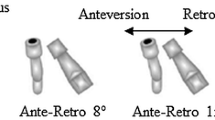Abstract
Modular components have certain distinct advantages and have been widely used at total hip replacement for almost two decades now. Modularity has provided the surgeon with the intraoperative flexibility to fine tune adjustments of limb length, offset, anteversion, head size, the requirement for and position of extended lip liners, etc. However, the levy for these benefits is the associated risk of fretting, corrosion, accelerated polyethylene wear, dissociation, etc.
Access this chapter
Tax calculation will be finalised at checkout
Purchases are for personal use only
Preview
Unable to display preview. Download preview PDF.
Similar content being viewed by others
References
Chmell MJ, Rispler D, Poss R. The impact of modularity in total hip arthroplasty. Clin Orthop 1995;319:77–84.
Harris WH. Modularity is unnecessary in primary femoral THA but has some advantage in primary acetabular THA. J Arthroplasty 1996;11(3):334–336.
Ritter MA, Keating EM, Faris PN, Brugo G. Metal-backed acetabular cups in total hip arthroplasty. J Bone Joint Surg 1990;72A:672–677.
Bartell DL, Bicknell VL, Wright TM. The effect of conformity, thickness and material on stresses in ultra-high molecular weight components for total joint replacement. J Bone Joint Surg 1986;68A:1041–1051.
Collier JP, Mayor MB, Jensen RE et al. Mechanisms of failure of modular prostheses. Clin Orthop 1992;285:129–139.
Learmonth ID, Hussell JG, Smith EJ. Inadequate polyethylene thickness and osteolysis in cementless hip arthroplasty. J Arthroplasty 1997;10(3):305–309.
Heck DA, Partridge CM, Ruben JD, Lenzer WL, Lewis CG, Keating EM. Prosthetic component failures in total hip arthroplasty surgery. J Arthroplasty 1995;10(5):575–580.
Bueche MJ, Herzenberg JE, Stubbs BT. Dissociation of a metal-backed polyethylene acetabular component. J Arthroplasty 1989;4(1):39–41.
Brien WW, Salvati EA, Betts F. Metal levels in cemented total hip arthroplasty: a comparison of well-fixed and loose implants. Clin Orthop 1992;276:66–74.
Kitzinger KJ, Delee JC, Evans JA. Dissassembly of a modular acetabular component of a total hip replacement arthroplasty. J Bone Joint Surg 1990;72A:621–623.
Huk OL, Bansal M, Betts F et al. Polyethylene and metal debris generated by non articulating surfaces of modular acetabular components. J Bone Joint Surg 1994;76B:568–574.
Parsley BS. Current concerns with modular metal-backed acetabular components. Proceedings of 59th Annual Meeting of the American Academy of Orthopaedic Surgeons, Washington, 1992; 83.
Bono JV, Sanford L, Toussaint JT. Severe polyethylene wear in total hip arthroplasty: observations from retrieved AML PLUS hip implants with an ACS polythylene liner. J Arthroplasty 1994;9:119–127.
Chen PC, Mead EH, Pinto JG, Colwell CW. Polyethylene wear debris in modular acetabular prostheses. Clin Orthop 1995;317:44–55.
Bobyn JD, Tanzer M, Krygier JJ, Dujoyne AR, Brooks CE. Concerns with modularity in total hip arthroplasty. Clin Orthop 1994;298:27–36.
Williams VG, Whiteside LA, White SE, McCarthy DS. Fixation of ultrahigh-molecular-weight polyethylene liners to metal-backed acetabular cups. J Arthroplasty 1997;12(1):25–31.
Lieberman JR, Kay RM, Hamlet WP, Park S-H, Kabo JM. Wear of polyethylene liner-metallic shell interface in modular acetabular components. J Arthroplasty 1996;11(5):602–608.
Tanzer M, Druker D, Jasty M, McDonald M, Harris WH. Revision of the acetabular component with an uncemented Harris Galante porous coated prosthesis. J Bone Joint Surg 1992;74A:987–994.
Wasielewski RC, Cooperstein LA, Kruger MP, Rubash HE. Acetabular anatomy and the transacetabular fixation of screws in total hip arthroplasty. J Bone Joint Surg 1990;72A:501–508.
Hozack WJ, Mesa JJ, Rothman RH. Head-neck modularity for total hip arthroplasty. J Arthroplasty 1996;11(4):397–399.
McCarthy JC, Bono JV, O’Donnell PJ. Custom and modular components in primary total hip replacement. Clin Orthop 1997;344:162–171.
Fisher J, Firkins P, Reeves EA, Hailey JL, Isaac GH. The influence of scratches to metallic counterfaces on the wear of ultra-high molecular weight polythylene. Proc Instn Mech Engr Part H 1996;209(H4):263–204.
Ries MD. Intra-operative modular stem lengthening to treat peri-prosthetic femur fractures. J Arthroplasty 1996;11(2):204–205.
Pellici PM, Haas SB. Disassembly of a modular femoral component during closed reduction of the dislocated femoral component. J Bone Joint Surg 1990;72A:619–620.
Krushell RJ, Burke DW, Harris WH. Elevated-rim acetabular components: effect on range of motion and stability in total hip arthroplasty. J Arthroplasty 1991;6:S53–58.
Harris WH. A new total hip implant. Clin Orthop 1971;81:105–113.
Collier JP, Mayor MB, Williams IR, Suprenant VA, Suprenant HP, Currier BH. The tradeoffs associated with modular hip prostheses Clin Orthop 1995;311:91–101.
Collier JP, Suprenant VA, Jensen RE, Mayor MB, Suprenant HP. Corrosion between the components of modular femoral hip prostheses. J Bone Joint Surg 1992;74B:511–517.
Lieberman JR, Rimmol CM, Garvin KL, Klein RW, Salvati EA. An analysis of the head-neck taper interface in retrieved hip prostheses. Clin Orthop 1994;300:162–187.
Levine DL, Staehle RW, Crevice corrosion in orthopaedic implant materials. J Biomed Mater Res 1977;11:553–561.
Cook SD, Barrack RL, Baffes GC et al. Wear and corrosion of modular interfaces in total hip replacements. Clin Orthop 1994;298:80–88.
Jasty M, Bragdon CR, Lee K, Hanson, A, Harris WH. Surface damage to cobalt-chrome femoral head prostheses. J Bone Joint Surg 1994;76B:73–77.
Mathiesen EB, Lindgren IU, Blomgren GGA, Reinholt FP. Corrosion of modular hip prostheses. J Bone Joint Surg 1991;73B:569–575.
Gilbert JL, Buckley CA, Jacobs W et al. Intergranular corrosion fatigue failure of cobalt alloy femoral stems: a fatigue analysis of two implants. J Bone Joint Surg 1994;76B:568–574.
Jacobs JJ, Urban RM, Gilbert JL et al. Local and distance products from modularity. Clin Orthop 1995;319:94–105.
Salvati EA, Lieberman JR, Huk OL, Evans BG. Complications of femoral and acetabular modularity. Clin Orthop 1995;319:85–93.
Huo MH, Fye MA, Martin RP, Zatorski LE, Keggi KJ. Unsatisfactory results of a first-generation modular femoral stem implanted without cement. J Arthroplasty 1997;12(5):490–496.
Editor information
Editors and Affiliations
Rights and permissions
Copyright information
© 2000 Springer-Verlag London
About this chapter
Cite this chapter
Learmonth, I.D. (2000). Clinical Implications of Component Modularity in Total Hip Replacement. In: Learmonth, I.D. (eds) Interfaces in Total Hip Arthroplasty. Springer, London. https://doi.org/10.1007/978-1-4471-0477-3_6
Download citation
DOI: https://doi.org/10.1007/978-1-4471-0477-3_6
Publisher Name: Springer, London
Print ISBN: 978-1-4471-1150-4
Online ISBN: 978-1-4471-0477-3
eBook Packages: Springer Book Archive



